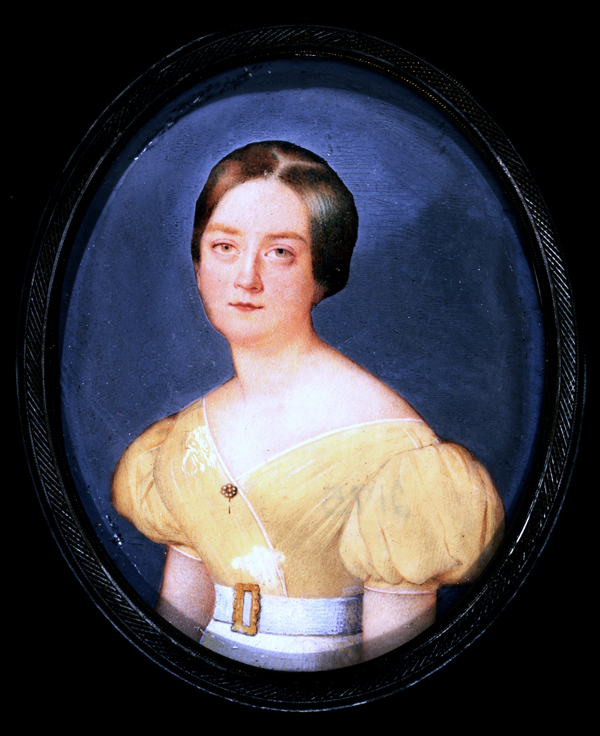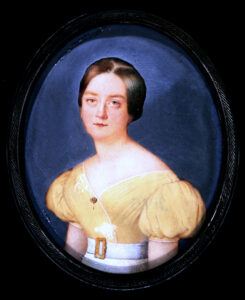Louis Antoine Collas
Louis Antoine Collas was an adept and very popular miniature portrait painter who regularly traveled to Louisiana to paint plantation owners and merchants.

Courtesy of Louisiana State Museum
Mrs. Andry. Collas, Louis Antoine (Artist)
Louis Antoine Collas was born in Bordeaux, France, in 1775 and was part of the first wave of European artists attracted to the growing commercial center of New Orleans. Biographers list him as studying in Paris with “F.A. Vincent and F. Andre.” This may refer to Antoine Paul Vincent, a Parisian miniaturist who exhibited at the French Salon between 1800 and 1812, and Louis François Aubry (1767–1851), Vincent’s distinguished pupil, who won medals at the Salon in 1808 an 1828, served as restorer at the Louvre, and was named Chevalier in the Legion of Honor. Other, more plausible records indicate that Collas studied with François André Vincent, and more probably with his son, Francois Andre.
Collas debuted at the Salon, with a single self-portrait, in 1798. The following year, he sent several miniatures. As was au courant, his style is characterized by a series of delicate crosshatched strokes resulting in a soft, almost pointillé treatment of the face. Miniaturists in England, France, Italy, the German Confederation, Spain, and the colonies began adopting the hatch- and dot method beginning in the mid-eighteenth century. Between 1803 (though it is claimed as late as 1808) and 1811, Collas was in St. Petersburg, Russia, working for the court of Czar Alexander I. Among others, he painted miniatures of Duchess Catherine Pavlowna and Prince Serge Nikolaewitch Galitinne. A number of miniaturists from various parts of Europe worked for the Russian court, including the husband-and-wife team Antonio and Nina Meucci, who were in New Orleans at various times between 1818 and 1827.
Returning to Paris, Collas exhibited at the Salon of 1812. Little is known about his activities from this point until 1816, when he is listed in the New York City directory as “Lewis Collers.” By this point, Collas also was painting portraits that, in terms of format and handling of planes and shading, suggest miniatures expanded to the proportions of a canvas. For example, his pendant portraits of the Jarreaus resemble scaled-up miniatures. Work by later artists trained as miniaturists, notably Julien Hudson’s attributed Self Portrait and the George David Coulon’s Boy with a Rose, provide this same effect.
Collas sent miniatures to the American Academy of Art annual exhibitions in New York between 1816 and 1820. He also showed miniatures at the Pennsylvania Academy of the Fine Arts exhibit in Philadelphia in 1819. Collas traveled up and down the East Coast, advertising in Philadelphia and Charleston, South Carolina. He may have visited New Orleans before 1822, the first year his name is recorded in the city. Identified as “portrait and miniature painter” living at 35 St. Peter Street, Collas had been preceded in painting the genre for local patrons by Jean-Francois de Vallee, a superior miniaturist, and the Meuccis, both less accomplished artists. Vallee and the Meuccis were successful but merited little notice in the press. A few advertisements and city directory listings comprise the only record. In contrast, Collas, like Edmund Brewster, managed to attract the attention of at least one critic. The following appeared in the Louisiana Gazette on January 20, 1823:
“We notice with pleasure at Mr. Elkin’s Exchange a Frame enclosing miniature paintings by Mr. Collas. The finish of his portraits leaves nothing to be desired for resemblance. We can compare it with the life-sized portrait above the frame. It is a speaking likeness. Everyone can recognize the artist whom one of his colleagues has delineated. Unfortunately, fate has snatched Lancelin [Vanderlyn?] from us. I do not pretend to make any comparison between the two painters, but I will limit myself by saying that the real and beautiful talent of Mr. Collas should be encouraged in all cities, and since those I have seen in France, I have found nothing more graceful than his works.”
Flattered, perhaps, the artist announced his return in New Orleans papers almost every year after this with notices such as “Collas, L. – Painter, Has the honor of informing his friends and the public of New Orleans, that he has returned to this city, and that he intends (while here) to exercise his art in portrait and miniatures.” Nearly identical ads appear in New Orleans papers thereafter, in 1823, 1824, 1826, 1827, and 1829. While later itinerant artists tended to arrive in October or November, Collas’s announcements usually appeared in April.
The subject of Collas’s portrait Madame Andrey was likely from the Andrey family (also spelled Andry or André) who were active in colonial and early federal militias in Louisiana, and owned plantations in St. James Parish. Collas depicts an older woman, possibly the widow André, who lived on Amour Street in 1829. Her piercing grey eyes seem a little sad, but artists and sitters also favored a slightly distant gaze to suggest contemplation, reverie, or deep emotion. There seems to be no connection between the Andrey family in Louisiana and Collas’s presumed teacher.
Collas’s sitter miniature is very likely the same Mrs. André who so intrigued John James Audubon. On February 21, 1821, Audubon wrote in his diary of “one of those discouraging Incidents connected with the life of the artists.” He continued, “I had a Likeness Spoken of in very rude terms by the fair Lady it was made for, and perhaps will Loos my time and the reward expected for my Labours.” Her criticism nagged at him, and he later identified her by name: “Mrs. André – I mention Name as I May speak more of the Likeness as the occasion will require.”
Collas returned to Paris in 1831 or 1832. He showed again at the Salon, but attracted little other notice as a painter. There is one additional, tantalizing clue, however. On September 9, 1841, the Louisiana Courier printed a long description of a system for copying statues, “an instrument purely mechanical” that “promises to bring the chefs d’oeuvres of art, not only into the homes but the shelves of saloons as well.” The invention is attributed to “Achilles Collas,” a plausible alias given his identity in New York. There is, however, no firm evidence that Collas returned to the United States. The Benézit Dictionary of Artists states that he died in 1856.
